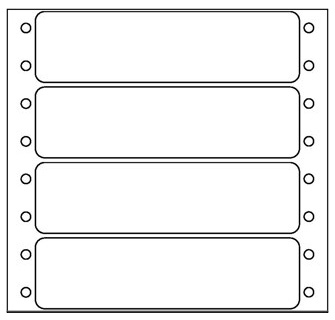Understanding How Blank Labels Work to Boost Your Labeling Experience
Recognizing the technicians of blank labels is important for maximizing your labeling practices throughout numerous contexts. These flexible devices use substantial advantages, such as modification and flexibility, making them a fitting selection for both specialist setups and individual usage. From inventory monitoring to home company, the effects of their strategic application can cause boosted efficiency. Nonetheless, to fully understand how these labels can change your processes, one should think about the different kinds offered and the myriad ways they can be tailored to fit details needs.

Benefits of Making Use Of Blank Labels
Blank labels supply a functional option for different labeling demands, making them important in both individual and expert settings. Their flexibility allows users to develop personalized labels tailored to particular demands, improving business efficiency. Whether made use of in home offices, retail atmospheres, or industrial applications, blank labels promote the identification and categorization of items, records, and individual products.
One considerable benefit of blank labels is their cost-effectiveness. By permitting customers to publish just the labels they require, waste is lessened, and inventory administration becomes more workable. Furthermore, blank labels work with numerous printing techniques, consisting of inkjet and laser printers, making them accessible for different individuals.

Furthermore, making use of blank labels streamlines the procedure of upgrading details, as users can conveniently print brand-new labels to replace out-of-date ones, guaranteeing that all items and documents are accurately labeled. On the whole, blank labels supply a practical and reliable labeling solution for diverse applications.
Kinds Of Blank Labels Available
What alternatives are readily available when it comes to blank labels? Blank labels come in a variety of types, each suited for different applications and choices.
One more prominent alternative is synthetic labels, frequently made from materials like polyester or vinyl. These labels are recognized for their longevity and resistance to water, chemicals, and tearing, making them appropriate for harsh environments. They are frequently made use of in industrial setups or for labeling items that may be exposed to wetness.
In addition, there are thermal transfer labels, which call for a printer that uses warm to transfer ink onto the label surface area. These labels are favored for their click over here now top notch print and durability.
Lastly, specialty labels satisfy certain demands, such as detachable labels for temporary use or high-temperature labels for extreme conditions. Understanding these options allows users to select the most proper blank tag for their distinct labeling requirements.
Modification Options for Labels
A broad array of personalization choices is readily available for labels, permitting customers to tailor them to specific requirements and branding needs. Users can pick from numerous sizes, forms, and materials to ensure that the labels properly fit their desired function. Usual products consist of paper, polyester, and vinyl, each offering different levels of resilience and aesthetic appeal.
Shade alternatives play a crucial function in modification, making have a peek at this website it possible for brand names to preserve consistency with their business identity. Customers can select from a range of shades or also opt for customized printing to match details branding components. In addition, labels can be printed with unique designs, logo designs, and text, enhancing brand recognition and aesthetic effect.
An additional important aspect is the option of adhesive. Tags can be designed with long-term, removable, or repositionable adhesives, depending upon the application demands. This versatility enables for reliable labeling solutions across different settings, from retail to commercial settings.

Tips for Effective Labeling
Reliable labeling goes beyond modification; it likewise entails strategic factors to consider that improve performance and communication. To achieve effective labeling, begin by plainly defining the objective of each label.
Following, focus on presence by selecting appropriate shades and typefaces. High comparison in between text and history enhances readability, while larger typefaces help with quick identification. In addition, ensure that labels are positioned in a regular and logical manner, making it simpler for users to situate and analyze information.
Think about the Click Here sturdiness of labels also. Choose materials fit for the specific setting where the labels will be used, whether it be indoors or outdoors. Water-proof or tear-resistant alternatives might be necessary depending upon the context.
Lastly, consistently evaluation and upgrade your labels to reflect any type of adjustments in information or usage. This aggressive method not only maintains quality yet additionally prevents complication over time. By following these suggestions, you can take full advantage of the efficiency of your labeling initiatives, guaranteeing they serve their designated function effectively.
Applications of Blank Labels
Blank labels supply many applications across different industries, making them an indispensable device for organization and communication. These functional labels are commonly made use of in storage facilities for stock management, allowing services to easily identify and track items. By applying blank labels to storage space bins, racks, or pallets, companies can streamline their procedures and decrease the probability of errors.
In the health care industry, blank labels play a critical role in identifying medications and clinical supplies, ensuring appropriate recognition and usage. Adjustable labels can consist of important details such as dosage, expiry days, and client information, enhancing security and compliance.
In retail, blank labels help in prices items, giving promotions, or labeling shelf places, which eventually improves the client experience. They enable fast updates to rates or item information without the requirement for pre-printed labels.
Furthermore, blank labels are advantageous for individual usage, such as organizing home workplaces, crafting, or identifying food containers. Their flexibility permits people to produce tailored remedies that meet specific needs. On the whole, the applications of blank labels are comprehensive, highlighting their significance in promoting effectiveness and quality in numerous settings.
Final Thought
In verdict, blank labels provide a versatile and effective remedy for numerous classifying needs. Ultimately, the integration of blank labels right into functional procedures adds to boosted efficiency, making them a vital source for both personal and specialist usage.